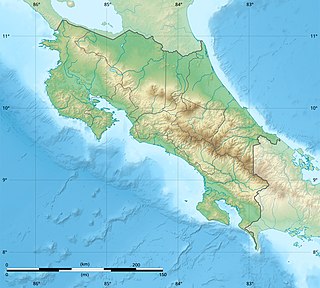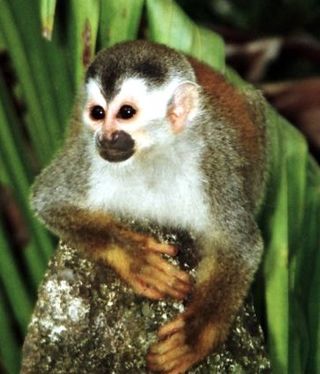
Costa Rica is located on the Central American Isthmus, surrounding the point 10° north of the equator and 84° west of the prime meridian. It has 212 km of Caribbean Sea coastline and 1,016 on the North Pacific Ocean.

A cloud forest, also called a water forest, primas forest, or tropical montane cloud forest, is a generally tropical or subtropical, evergreen, montane, moist forest characterized by a persistent, frequent or seasonal low-level cloud cover, usually at the canopy level, formally described in the International Cloud Atlas (2017) as silvagenitus. Cloud forests often exhibit an abundance of mosses covering the ground and vegetation, in which case they are also referred to as mossy forests. Mossy forests usually develop on the saddles of mountains, where moisture introduced by settling clouds is more effectively retained.

Alajuela is a province of Costa Rica. It is located in the north-central part of the country, bordering Nicaragua to the north. It also borders the provinces of Heredia to the east, San José to the south, Puntarenas to the southwest and Guanacaste to the west. As of 2011, the province had a population of 885,571. Alajuela is composed of 16 cantons, which are divided into 111 districts. It covers an area of 9,757.53 square kilometers.

Monteverde is the twelfth canton of the Puntarenas province of Costa Rica. It is located in the Cordillera de Tilarán mountain range. Roughly a four-hour drive from the Central Valley, Monteverde is one of the country's major ecotourism destinations. The area is host to the Monteverde Cloud Forest Reserve and several other natural attractions, which draw considerable numbers of tourists and naturalists.

The wildlife of Costa Rica comprises all naturally occurring animals, fungi and plants that reside in this Central American country. Costa Rica supports an enormous variety of wildlife, due in large part to its geographic position between North and South America, its neotropical climate, and its wide variety of habitats. Costa Rica is home to more than 500,000 species, which represent nearly 5% of the species estimated worldwide, making Costa Rica one of the 20 countries with the highest biodiversity in the world. Of these 500,000 species, a little more than 300,000 are insects.

Corcovado National Park is a National Park on the Osa Peninsula, in Osa Canton, located on the southwestern regions of Costa Rica, which is a part of the Osa Conservation Area. Corcovado National Park was established in October 24 1975 and occupies an area of 424 square kilometres (164 sq mi). It is currently the largest park in Costa Rica and extends over about a third of the Osa Peninsula.

The Central American squirrel monkey, also known as the red-backed squirrel monkey, is a squirrel monkey species from the Pacific coast of Costa Rica and Panama. It is restricted to the northwestern tip of Panama near the border with Costa Rica, and the central and southern Pacific coast of Costa Rica, primarily in Manuel Antonio and Corcovado National Parks.

Golfo Dulce is a gulf in Costa Rica, located at the south of the Province of Puntarenas. The inlet starts on the Pacific Ocean side of Costa Rica and extends slightly northward before turning west. The most westward part is at the city of Rincon. The bay separates the Osa Peninsula from the mainland Costa Rica.

Bothriechis schlegelii, known commonly as the eyelash viper, is a species of venomous pit viper in the family Viperidae. The species is native to Central and South America. Small and arboreal, this species is characterized by a wide array of color variations, as well as the superciliary scales above the eyes. It is the most common of the green palm-pitvipers, and is often present in zoological exhibits. The specific name schlegelii honors Hermann Schlegel, who was a German ornithologist and herpetologist. For other common names see below. No subspecies are currently recognized as being valid.
Roger Conant was an American herpetologist, author, educator and conservationist. He was Director Emeritus of the Philadelphia Zoo and adjunct professor at the University of New Mexico. He wrote one of the first comprehensive field guides for North American reptiles in 1958 entitled: A Field Guide to Reptiles and Amphibians of Eastern and Central North America, in the Peterson Field Guide series.

Tourism in Costa Rica has been one of the fastest growing economic sectors of the country and by 1995 became the largest foreign exchange earner. Since 1999, tourism has earned more foreign exchange than bananas, pineapples and coffee exports combined. The tourism boom began in 1987, with the number of visitors up from 329,000 in 1988, through 1.03 million in 1999, over 2 million in 2008, to a historical record of 2.66 million foreign visitors in 2015. In 2012, tourism contributed with 12.5% of the country's GDP and it was responsible for 11.7% of direct and indirect employment. In 2009, tourism attracted 17% of foreign direct investment inflows, and 13% in average between 2000 and 2009. In 2010, the tourism industry was responsible for 21.2% of foreign exchange generated by all exports. According to a 2007 report by ECLAC, tourism contributed to a reduction in poverty of 3% in the country.

The Monteverde Cloud Forest Reserve is a Costa Rican reserve located along the Cordillera de Tilarán within the Puntarenas and Alajuela provinces. Named after the nearby town of Monteverde and founded in 1972, the Reserve consists of over 10,500 hectares of cloud forest. It draws roughly 70,000 visitors a year. The Reserve consists of 6 ecological zones, 90% of which are virgin forest. A high biodiversity, consisting of over 2,500 plant species, 100 species of mammals, 400 bird species, 120 reptilian and amphibian species, and thousands of insects, has drawn both scientists and tourists alike.

The Selvatura Adventure Park, or Monteverde Nature Center, Hummingbird and Butterfly Gardens is a nature center in Monteverde, northwestern Puntarenas Province, Costa Rica. It is located in the Cordillera de Tilarán mountain range, close to the village of Santa Elena.
The Jaguar Rescue Center is an animal rescue center located near Puerto Viejo de Talamanca in the Limón Province of Costa Rica. The center is dedicated to the rehabilitation of mistreated, injured, orphaned, and/or confiscated animals. Once the animals are fully rehabilitated, they are reintroduced into their natural habitats in protected areas within Costa Rica, usually after a period in La Ceiba primary forest. Visitors are permitted in the center during certain times each day. The center was founded by the Italian biologist Sandro Alviani and his wife Encar García, a Catalan biologist, who runs it with help of volunteers from all around the world and hosts numerous mammals, birds, reptiles, and amphibians. The center also houses a large serpentarium of venomous and nonvenomous snakes native to Costa Rica.

Rescate Wildlife Rescue Center, formerly Rescate Animal Zoo Ave, is an urban park of approximately 14 hectares, located in La Garita, in the canton of Alajuela, Costa Rica. It has an average altitude of 814 meters and is bounded to the north by the bed of the river Rio Poas. The site includes the largest collection of bird species in Latin America.

Centro de Rescate Las Pumas is a rural park of approximately 14 hectares, located in southern Cañas, in the Guanacaste Province, Costa Rica.
Parque Nacional Simón Bolívar is an urban park of approximately 14 hectares, located in downtown San José, Costa Rica. It is the oldest botanical garden and zoo in Costa Rica. The name pays homage to Latin American national founder Simón Bolívar. It is administered by a conservation nonprofit foundation called Fundazoo. All animals in the zoo are orphaned, injured or have been disabled and are nursed back to health in hopes of releasing them.

The Arenal Eco Zoo is a nature center located in western Alajuela Province, Costa Rica. It is located across Lake Arenal, west of Arenal Volcano National Park, right at the border between Alajuela and Guanacaste Provinces.

Project Vibroana is a privately operated serpentarium, rescue centre and environmental education facility located near Turrialba Volcano in the Cartago Province of Costa Rica. The centre is dedicated to the rehabilitation of mistreated, injured, orphaned, and/or confiscated snakes, focusing primarily on venomous species. Once the animals are fully rehabilitated, they are reintroduced into their natural habitats in protected areas, mainly in the Pacuare River primary forest. Visitors are permitted in the centre during certain times each day. The center was created and is run by Minor Camacho, a Costa Rican herpetologist. The educational guide explores the natural history and habitat of poisonous snakes more than their taxonomy.

The Monteverde Theme Park, previously known as Frog Pond Ranarium, located in Santa Elena, north of Monteverde, Puntarenas Province, Costa Rica, is a frog pond turned animal theme park that houses a butterfly farm with approximately 30 live butterfly species and other insects and over 25 species of frogs and other amphibians from around the country in a climate controlled habitat.


















